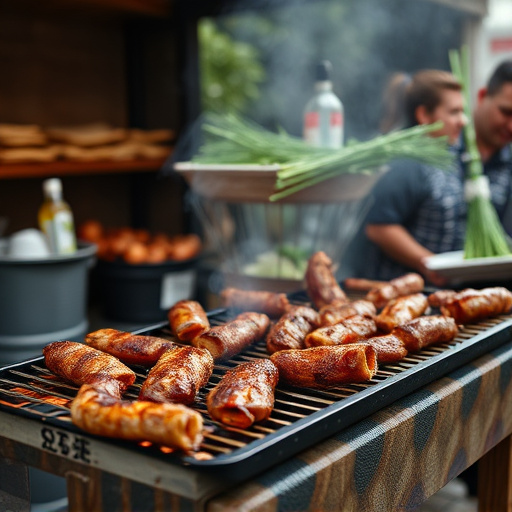Selecting lean cuts, thin slicing against the grain, and using sharp tools enhance jerky quality. Balance acidity, sweetness, salt, and spice for flavorful tender meat. Choose between marinades or dry rubs for texture and flavor. Cook at low temps (160°F-225°F) for 4-8 hours. Understand protein denaturation and control humidity during drying. Slice meat uniformly (1/4-inch thick) to ensure even cooking. Cool jerky fully, store in airtight containers in cool, dark places.
Achieve perfect BBQ jerky texture with our comprehensive guide. Discover the ideal cut of meat for tender jerky, the importance of seasoning in flavor and texture development, and the science behind protein denaturation. Learn about marinade vs. dry-rub methods, optimal cooking times and temperatures, slice thickness impact, and storage tips. Elevate your BBQ jerky recipe with these expert tips for a satisfying, perfectly textured snack.
- Choose the Right Cut of Meat for Tender Jerky
- Seasoning: The Key to Flavor and Texture
- Marinade or Dry-Rub: Which Method is Better?
- Cooking Time and Temperature Control
- The Science Behind Protein Denaturation
- Slice Thickness: Impact on Textural Perfection
- Proper Cooling and Storage for Lasting Jerky Quality
Choose the Right Cut of Meat for Tender Jerky
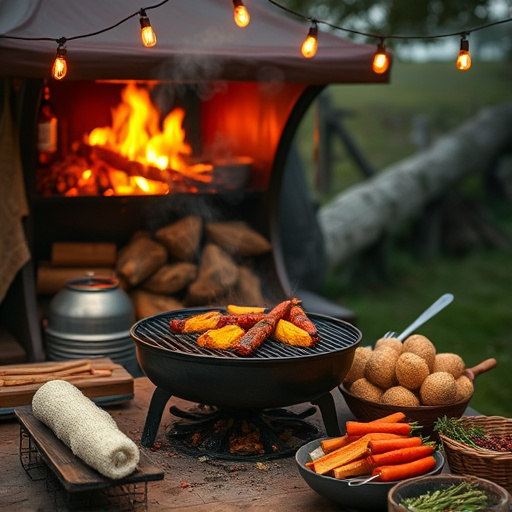
To achieve the perfect tender and juicy BBQ jerky, selecting the right cut of meat is a crucial step. Look for lean cuts with minimal fat content, as higher fat can result in a chewier texture and more difficult drying process. The most common choices are thin-cut beef sirloin or round steak. These cuts have less connective tissue and fat, making them ideal for jerky. When preparing your BBQ jerky recipe, cutting the meat into thin slices ensures even cooking and drying, leading to a consistent and tender end product.
Remember, the quality of your jerky begins with the quality of your ingredients. Using a sharp knife or meat slicer, slice the meat against the grain for maximum tenderness. This simple step can significantly improve the overall texture of your BBQ jerky recipe, making it more enjoyable to eat and showcasing the delicious flavors you’ve prepared.
Seasoning: The Key to Flavor and Texture
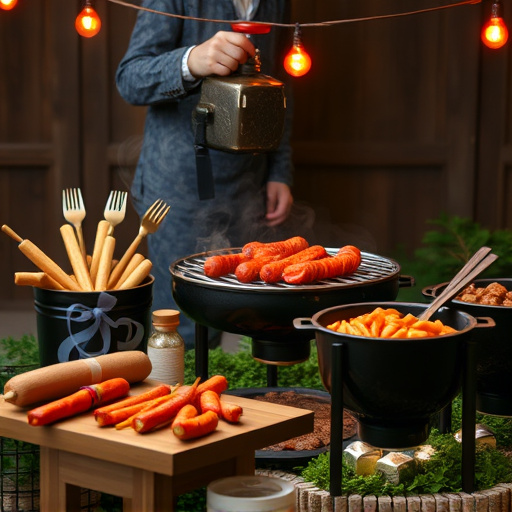
Achieving the perfect BBQ jerky texture involves more than just mastering the cooking process; seasoning plays a pivotal role in both flavor and texture development. The right blend of spices and marinades can transform simple beef (or any protein) into a delectable, chewy delight. When crafting your BBQ jerky recipe, focus on balancing acidity, sweetness, saltiness, and spiciness to enhance the meat’s natural flavors.
Acidic components like lemon juice or vinegar help break down proteins, contributing to that desirable tender texture. Sweeteners such as brown sugar or maple syrup add a sticky coating that not only glazes the jerky during cooking but also seals in moisture, preventing it from becoming overly dry and brittle. Salt enhances both flavor and preservation, drawing out juices and ensuring your jerky stays juicy. Spices like chili powder or paprika provide heat and depth, while optional additions like garlic and onion powders offer familiar savory notes. Experimenting with these elements will lead you closer to perfecting not just the taste but also the satisfying, chewy texture that makes BBQ jerky such a beloved treat.
Marinade or Dry-Rub: Which Method is Better?
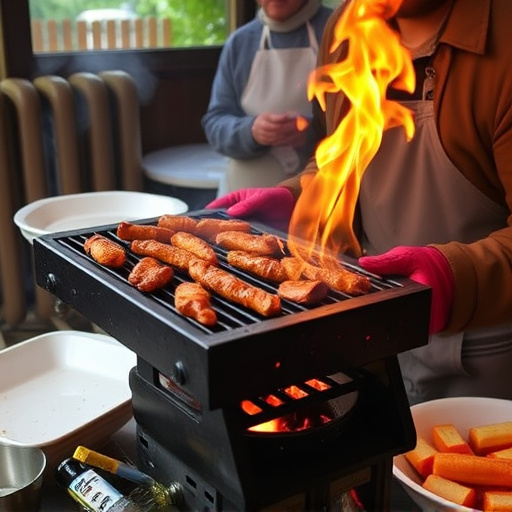
When it comes to achieving that perfect BBQ jerky texture, the choice between a marinade or dry rub is a key decision. Both methods have their advocates, but let’s break down the pros and cons for each to help you decide for your next BBQ jerky recipe.
Marinades offer a moist, tenderizing effect on the meat, making it easier to chew and ensuring a consistent texture throughout. This method is ideal if you prefer a slightly softer, more flexible jerky that melts in your mouth. However, marinades can sometimes result in an overly salty taste or lead to uneven seasoning absorption. Dry rubs, on the other hand, create a tougher, chewier jerky with a more intense smoky flavor due to the direct contact of spices with the meat surface. This method is perfect for those who prefer a robust, satisfying bite and don’t mind a slightly firmer texture.
Cooking Time and Temperature Control
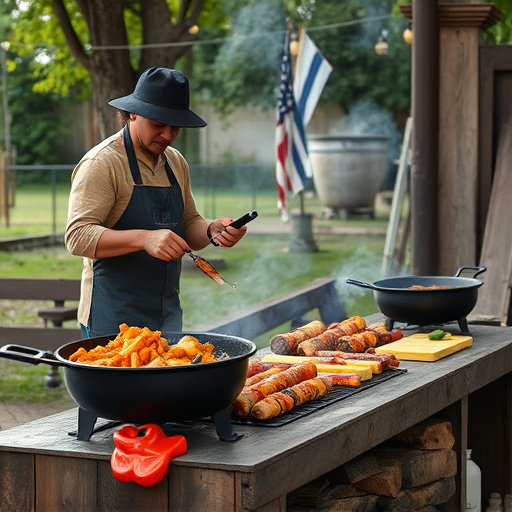
Achieving the perfect BBQ jerky texture requires precise control over cooking time and temperature. Generally, jerky is best cooked at lower temperatures—typically between 160°F to 225°F (71°C to 107°C)—for an extended period of time. This slow, low-temperature process allows the fat to render and the collagen in the meat to break down, resulting in a tender, chewy texture that’s characteristic of great BBQ jerky. Time can vary widely depending on the thickness of your slices and whether you’re using beef, turkey, or another type of meat, but plan for 4-8 hours of cooking time. Regularly checking the internal temperature with a meat thermometer will ensure your jerky is thoroughly cooked without overdoing it, preventing a tough or dry final product in your BBQ jerky recipe.
The Science Behind Protein Denaturation
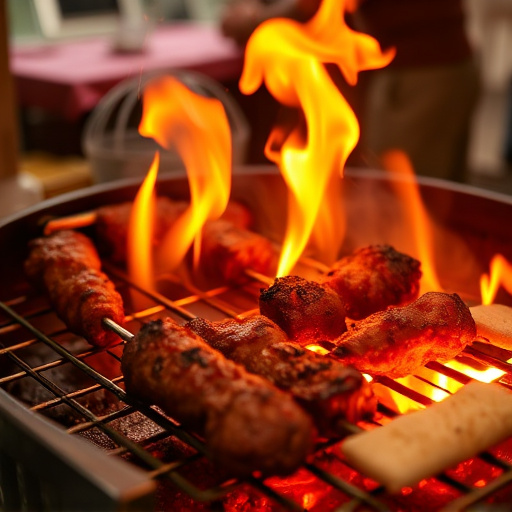
The process of making perfect BBQ jerky involves understanding the science behind protein denaturation. This crucial step is what transforms thin slices of meat into tender, chewy treats. Protein denaturation occurs when the long strands of protein in muscle tissue are broken down and realigned during cooking. In a BBQ jerky recipe, heat causes these proteins to unravel, making the meat more susceptible to absorbing flavors from marinades and spices. This transformation not only enhances taste but also ensures the desired texture, where each bite provides a satisfying crunch and slow-release of juices.
Additionally, the control of temperature and humidity during the drying process plays a vital role. As the meat cools and dries, proteins further solidify, locking in flavors and ensuring the jerky retains its shape. This meticulous balance between cooking and drying is key to achieving that ideal BBQ jerky texture that satisfies both the taste buds and the desire for a delightful, long-lasting snack experience.
Slice Thickness: Impact on Textural Perfection
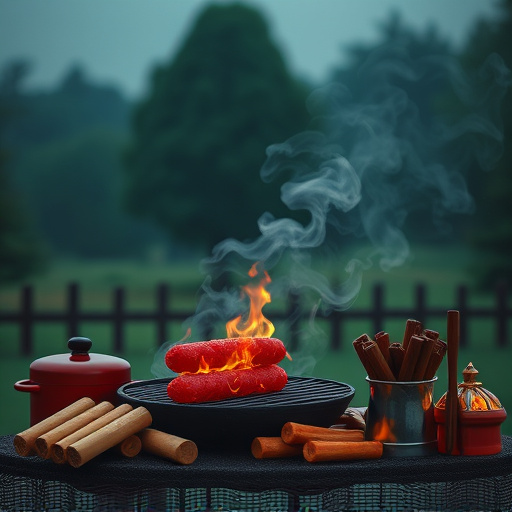
The slice thickness of your meat is a key factor in achieving the perfect BBQ jerky texture. Using a sharp knife, cut your seasoned meat into even slices, typically around 1/4-inch (0.6 cm) thick. This consistent thickness ensures even cooking and helps prevent over-drying or under-cooking. Thicker slices may result in tough jerky, while thinner ones can become brittle. Aim for uniform thickness throughout the batch for optimal textural perfection in your homemade BBQ jerky recipe.
Proper Cooling and Storage for Lasting Jerky Quality
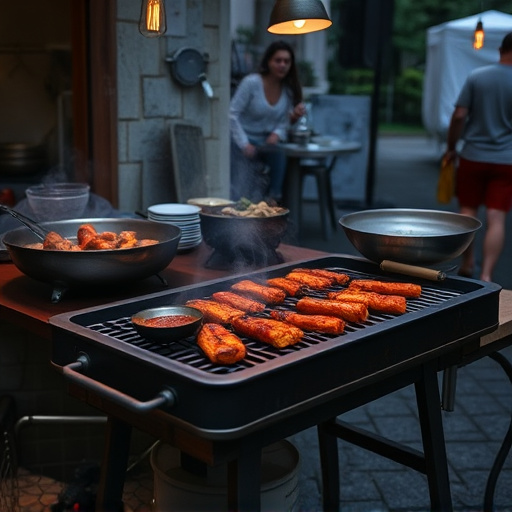
After mastering the art of marinating and cooking your BBQ jerky, proper cooling and storage are essential steps to ensure lasting quality. Allow the jerky to cool down completely before moving it to a clean, dry place. This helps prevent bacterial growth and maintains the desired texture. Store your homemade BBQ jerky in an airtight container, preferably in a cool, dark pantry or refrigerator. Proper storage can extend the shelf life of jerky by several weeks, keeping it fresh and flavorful.
Remember that consistent temperature is key; avoid exposing jerky to direct sunlight or extreme heat, as this can cause degradation. By following these simple cooling and storage guidelines, your BBQ jerky recipe will stay delicious and crispy for longer, satisfying your cravings well after the initial batch.
